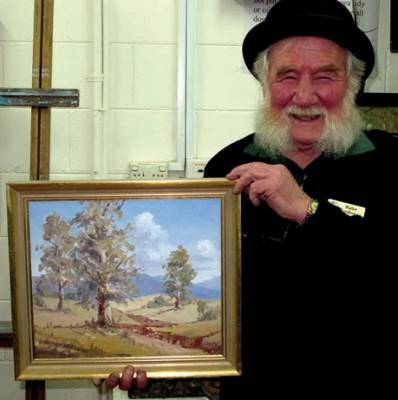Walter Magilton Demonstration 16th August 2014
Landscape in Oils
 The
subject Walter chose today was Gum Trees. "Not another bloody gum tree".
He said trees can never be worn out as a subject. Eucalypts are spread
world-wide and there was even a group in California called the Eucalyptus
School because of the popularity of that tree in their plein air works.
The
subject Walter chose today was Gum Trees. "Not another bloody gum tree".
He said trees can never be worn out as a subject. Eucalypts are spread
world-wide and there was even a group in California called the Eucalyptus
School because of the popularity of that tree in their plein air works.
Walter brought a series of paintings in different media where the main
subject is trees. However that is not all he paints. He doesn't like
specialising - painting the same subject over and over is boring.
In top paintings there are three statements:
● A statement about the subject
● A statement about the medium
● A statement about oneself - what have you done that no one else can do.
 A
watercolour painting of Walter’s that he used as his composition
A
watercolour painting of Walter’s that he used as his composition
In the art world it is important to make it on
your own style. We are not here to copy nature; we are here to improve on
it. When you look at a good painting you don't know what liberties the
artist has taken. One example is Streeton who added cumulus clouds to a
lot of his paintings even though they may not have been there. The reason
is that they cast shadows which add to the composition. Walter put out a
limited palette of colours - Prussian Blue, Cobalt Blue, White, flesh
pink, Yellow Ochre, Light Red, Pilbara Red, Burnt Sienna and Burnt Umber.
As mediums he uses Artist's Turpentine and Stretchers Medium No. 1. He
prefers soft acrylic brushes as they spread the paint better and he has a
handful of small brushes about size 2 which are old so there is no point
and they enable a soft touch for detailed work and they don't stir the
paint underneath. He emphasised that we shouldn't start with the small
brushes - start big. He prefers chisel point brushes but emphasises that
we should use what works for us.
When starting on the painting you need to decide where the light is coming
from and what the major interest is. Some parts of the painting are there
as a suggestion only. Don't be too explicit. Allow people's imaginations
to take over.
To produce the painting there are three steps:
● Step one is to get rid of the virgin white canvas. He painted a quick
wash of blue gradually changing to reds and greens to cover the canvas.
● Step two is drawing the composition. This is the hardest part. If you
don't have a good composition you will never have a good painting.
● Step three is applying the paint.
He quickly sketches in the composition using a reddish brown. Sometimes he
draws in charcoal, fixes that then applies the preliminary washes over
that. He never draws in Raw Umber - regards that as a dirty colour.
When composing he avoids dividing the canvas into thirds - prefers 2/5 and
3/5. You also don't want to divide the canvas into two halves. Also don't
have a line running into the corner. He describes that as creating an
arrow head and that is where it will lead the viewer - out of the
painting. He uses a large viewing square in the same ratio as the
dimensions of the canvas. He moves this around until he gets the "Wow"
factor.
To create balance in the composition is important. He illustrated that
with an elephant and mouse scenario. If you put 2 elephants on a seesaw
they will balance, but that is boring. You put the elephant on one end and
load the other with a lot of mice. In other words - one large thing in the
painting and lots of small things.
His method of working is top down and background forward. He begins with
the blue of the sky - it is the furthest thing away in the painting. When
adding the clouds make sure that they are not all uniform. Next came bluey
mauve for the mountains - keep the ones furthest away lighter so that you
save the darks for the foreground. "Keep the darks up your sleeve for as
long as possible". Sharp edges come forward and soft edges go back,
however he needs to add a sharp edge on the mountains so that we can read
that one is front of the other. As you change distance in the painting,
change tone.
After finishing the mountains and distant trees, the foreground hills and
mapping out the dry
 creek
bed, he is ready for the main focus - the two large gum trees.
creek
bed, he is ready for the main focus - the two large gum trees.
There are three sides to a tree - far, inner and near. He begins with the
far side - the foliage behind. Then the inner side - the framework of
trunk and branches and finally the near side - the foliage in front of the
tree. The nearer tree has a darker colour on the foliage to push the other
tree back. He works quickly now as time is running out.
Finally using the soft No 2 brush he adds some detail in the dry creek bed
and in the grasses on the hillsides. He prefers to keep the foreground
dark so that the viewer's eye is taken into the main part of the picture.
The finished painting
Helen Halliday, WAA Newsletter Editor